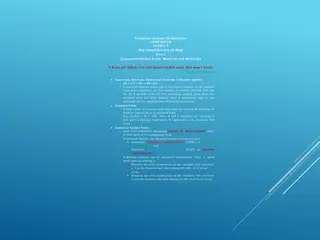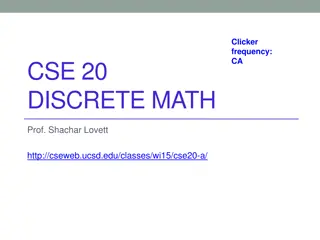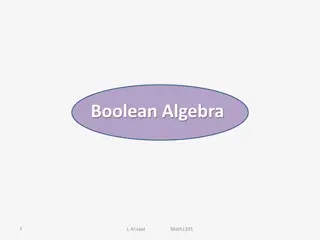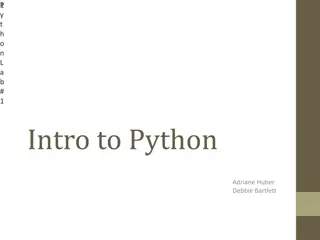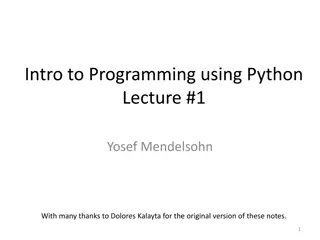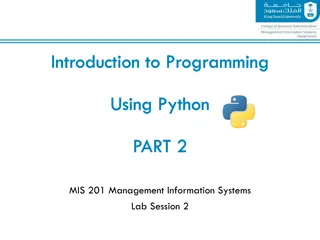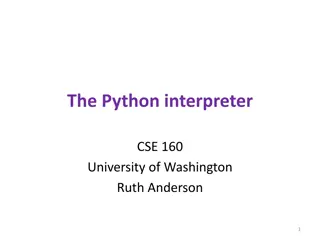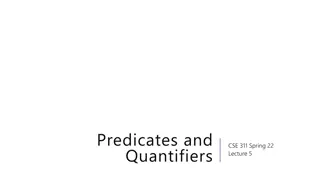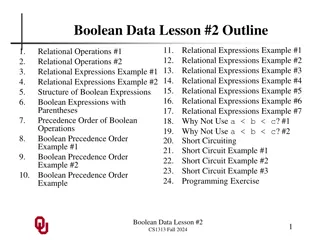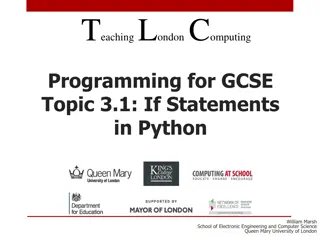Boolean Expressions and Comparisons in Python
Boolean expressions and comparisons in Python involve using operators to evaluate conditions and generate boolean results. The language's reserved keywords, True and False, play a crucial role in determining the validity of expressions. Whether comparing numerical values, strings, or utilizing comparison operators like equality (==), not equal (!=), less than (), less than or equal to (=), understanding how boolean expressions work is essential for writing effective Python code.
Download Presentation

Please find below an Image/Link to download the presentation.
The content on the website is provided AS IS for your information and personal use only. It may not be sold, licensed, or shared on other websites without obtaining consent from the author.If you encounter any issues during the download, it is possible that the publisher has removed the file from their server.
You are allowed to download the files provided on this website for personal or commercial use, subject to the condition that they are used lawfully. All files are the property of their respective owners.
The content on the website is provided AS IS for your information and personal use only. It may not be sold, licensed, or shared on other websites without obtaining consent from the author.
E N D
Presentation Transcript
If Statements and Boolean Expressions CSE 1310 Introduction to Computers and Programming Vassilis Athitsos University of Texas at Arlington Credits: a significant part of this material has been created by Dr. Darin Brezeale and Dr. Gian Luca Mariottini 1
The Boolean Type Expressions of type boolean can only have two values: True, or False. True and False are reserved keywords in Python. >>> b = 4; >>> a = (b != 5) >>> a True >>> a = 3 == 2 >>> a False >>> a = (3 == 2) >>> a False >>> 3 > 2 True >>> type(True) <type 'bool'> Preferred style (parenthesize) 2
Comparisons Generating Booleans The following operators compare numerical values, or strings, and generate boolean results: == equality != not equal < less than > greater than <= less than or equal to >= greater than or equal to 3
Doing Numerical Comparisons >>> a = 3 >>> b = 5 >>> c = 3 >>> a == b False >>> a == c True >>> a >= c True >>> a != c False 4
Doing Comparisons on Strings >>> a = "hello" >>> b = "goodbye" >>> c = "hello" >>> a != "hello" False >>> a == "hello" True >>> a != b True >>> a < "sky" True >>> "apple" < "car" True >>> "apple" < "Car" False >>> a == b False >>> a == c True >>> a < b False >>> a >= "world" False 5
Doing Comparisons on Strings Note how "greater than" and "less than" behave on strings: Not exactly based on alphabetical order. Capital letters come before (are "less than") lower case letters. >>> "apple" < "car" True >>> "apple" < "Car" False 6
Logical Operators The following logical operators can be used to produce boolean results: not and or 7
Using Logical Operators >>> a = 3 >>> b = 4 >>> (a == b) or (a+b == 7) True >>> (a == b) and (a+b == 7) False >>> not(a == b) True 8
The in operator The in operator checks if a value is included in a set of values. For now, we will use in to check if a letter appears in a string. We will see more uses when we do lists. >>> var1 = 'a' >>> vowels = 'aeiouAEIOU' >>> var1 in vowels True >>> 'c' in vowels False 9
Combining operators What does this line do? >>> (3 == 5) and (2 < 3) or (3 >= 0) 10
Combining operators What does this line do? >>> (3 == 5) and (2 < 3) or (3 >= 0) I don't know, and I don't want to know. Use parentheses to make the meaning of these statements clear. >>> ((3 == 5) and (2 < 3)) or (3 >= 0) True >>> (3 == 5) and ((2 < 3) or (3 >= 0)) False 11
Conditionals - if statements An if statement is defined as follows: if (expression): line 1 line 2 line n Line 1, line 2, , line n are called the body of the if statement. 12
An example of an ifstatement number_text = input("enter a number: ") number = float(number_text) if (number > 2): print(number, "is greater than 2") print("good bye") 13
Another example of an ifstatement number_text = input("enter a number: ") number = float(number_text) if (number > 2) and (number < 34): print(number, "is greater than 2") print(number, "is less than 34") print("good bye") 14
Conditionals - if-else An if-else statement is defined as follows: if (expression): one or more lines else: one or more lines 15
An example of an if-elsestatement number_text = input("enter a number: ") number = float(number_text) if (number > 2): print(number, "is greater than 2") else: print(number, "is less than or equal to 2") print("good bye") 16
Another example of an if-else number_text = input("enter a number: ") number = float(number_text) if (number > 2) and (number < 34): print(number, "is greater than 2") print(number, "is less than 34") else: print(number, "is less than or equal to 2") print("or greater than or equal to 34") print("good bye") 17
Conditionals - elif An if-else can include additional conditions, using elif: if (expression1): one or more lines elif (expression2): one or more lines. elif (expression2): one or more lines 18
Conditionals - elif You can use elif zero, one, or more times. if (expression1): one or more lines elif (expression2): one or more lines. elif (expression2): one or more lines 19
An example of using elif number_text = input("enter a number: ") number = float(number_text) if (number > 2) and (number < 34): print(number, "is greater than 2") print(number, "is less than 34") elif (number <= 2): print(number, "is less than or equal to 2") elif (number >= 34): print(number, "is greater than or equal to 34") print("good bye") 20
Another example of using elif number_text = input("enter a number: ") number = float(number_text) if (number > 2) and (number < 34): print(number, "is greater than 2") print(number, "is less than 34") elif (number <= 2): print(number, "is less than or equal to 2") else: print(number, "is greater than or equal to 34") print("good bye") 21
Warning Be careful of the difference between = and == 22
The Importance of Indentation number_text = input("enter a number: ") number = float(number_text) if (number > 2) and (number < 34): print(number, "is greater than 2") print(number, "is less than 34") These two programs behave differently. print("good bye") How, and why? number_text = input("enter a number: ") number = float(number_text) if (number > 2) and (number < 34): print(number, "is greater than 2") print(number, "is less than 34") print("good bye") 23
Successive ifs, vs. if-elif number_text = input("enter a number: ") number = float(number_text) if (number > 2) print(number, "is greater than 2") if (number > 10) print(number, "is greater than 10") if (number > 50) print(number, "is greater than 50") These two programs behave differently. How, and why? number_text = input("enter a number: ") number = float(number_text) if (number > 2) print(number, "is greater than 2") elif (number > 10) print(number, "is greater than 10") elif (number > 50) print(number, "is greater than 50") 24
Conditionals with Strings: Example 1 m = input("Enter the name of a month: ") if (m == "January") or (m == "March") or (m == "May") or (m == "July"): print(m, "has 31 days.") elif (m == "August") or (m == "October") or (m == "December"): print(m, "has 31 days.") elif (m == "April") or (m == "June") or (m == "September") or (m == "November"): print(m, "has 30 days.") elif (m == "February"): print(m, "has 28 or 29 days.") else: print(m, "is not a valid month") 25
Conditionals with Strings: Example 1 text = input("Enter a word: ") if ('a' in text) or ('A' in text): print(text, "contains at least one 'a'") else: print(text, "contains no 'a'") if ('b' in text) or ('B' in text): print(text, "contains at least one 'b'") else: print(text, "contains no 'b'") 26













